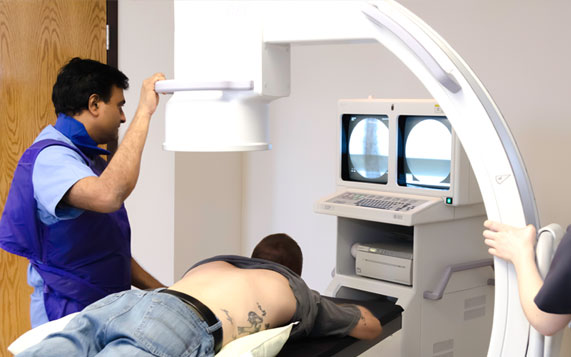Mission statement
Providing Patient-Centered care with innovative pain management services. We strive to deliver the most advanced, minimally invasive, diagnostic & therapeutic services available. We seek to enable our patients to restore function, relieve pain and have renewed hope.
Aboutus

At Pain Relief Centers, we offer a variety of services to help patients with chronic pain. Specifically, we use the multidisciplinary pain treatment approach in providing you the greatest chance for improvement and highest quality of care. We eagerly look forward to helping you at one of our clinics in metropolitan Louisville area.
PAIN TREATMENT OPTIONS
After conservative treatment techniques have been trialed, we may implement interventional treatment options that would include many different types of injections and procedures. Initially, targeted, safe injections are implemented and if inadequate progress is made with these injections then more advanced techniques like spinal cord implants or intrathecal pump implants may be considered.
Opioids and Chronic Pain Management
Epidural Steroid Injections
What is it for?
Epidural Steroid Injections (ESIs) are a common method of treating inflammation associated with back pain, lower back related leg pain, or neck related arm pain. In each of these conditions, the spinal nerves become inflamed due to narrowing of the passages where the nerves travel as they pass down or out of the spine. This narrowing can be caused by a misalignment of vertebrae, joint cysts, bone spurs, disc hernias, and more.
Cervical Epidural Steroid Injection
Caudal Epidural Steroid Injection
Thoracic Epidural Steroid Injection
Lumbar Epidural Steroid Injection
How is it done?
During an ESI, a needle is placed into the back of the epidural space, which surrounds the protective layer of the spinal cord known as the dura. An anti-inflammatory steroid will then be delivered into this area. A contrast dye will be used to insure the steroid is reaching the desired area, and the entire procedure will be done using fluoroscopic (x-ray) guidance. Often, a local anesthetic is added to provide some immediate pain relief.
This is an outpatient procedure, and you can normally return to your regular activity as early as the following day.
What can I expect afterwards?
Typically, the steroid will begin working within 1 to 3 days. Some cases can take up to a week before feeling the benefits. Pain relief will vary between patients, but most report relief lasting several months or more. Other times, if there is no underlying bone or joint issue, one injection can provide long-term pain relief. If your pain is caused by injury to more than one area, only some of your symptoms may be helped by just one injection.
Facet Joint Injections
What is it for?
Facet Joint Injections are used to either determine if the facet joint is the source of pain, or as a treatment for an abnormally with the joint that is contributing to lower back pain. These joints are located on the back of the spine on either side where two vertebrae meet. They provide stability for the spine and allow it to bend and twist.
How is it done?
With the guidance of a fluoroscope (x-ray), a needle will be inserted into the spinal area in question. An anti-inflammatory steroid will then be injected into either the facet joint itself, or onto the nerve.
This is an outpatient procedure, and you can normally return to your regular activity as early as the following day.
What can I expect afterwards?
You will typically be observed for 15-30 minutes after procedure. You will be able to walk and behave as you normally would after the procedure, but should avoid any strenuous activity the rest of the day.
The steroid may take 48-72 hours up to 1-2 weeks to begin relieving pain. Your progress will be reported at the follow-up visit after the procedure. Repeat injections may be considered depending on pain relief provided.
Knee/Shoulder Joint Injections
What is it for?
These are joint injections of a synovial joint in the body, which are most commonly knee and shoulder injections. They are used to reduce inflammation in these joints, which helps reduce pain significantly, and allow the patient to move the joint more comfortably.
How is it done?
Typically using the aid of an ultrasound, a needle will be inserted into the joint space as to come in contact with the inflamed structures. The medication will then be injected. A local anesthetic may be administered beforehand.
This is an outpatient procedure, and you can normally return to your regular activity as early as the following day.
What can I expect afterwards?
You will be able to walk and behave as you normally would after the procedure, but may want to go easy on the treated joint for a few hours.
In most cases, the effects can last for a few weeks to a few months. After this time the pain could return, requiring repeated injections.
Spinal Cord Stimulation (Medtronic)
Osteoarthritis of the Spine
Spondylosis
Stellate Ganglion Blocks
What is it?
A Stellate Ganglion Block is an injection of local anesthetic in the sympathetic nerve tissue of the neck. These nerves are a part of the sympathetic nervous system, and are located on either side of the voice box. This treatment will block the sympathetic nerves that go to the arms, and, to some degree, the sympathetic nerves that go to the face. This may in turn reduce pain, swelling, color and sweating changes in the upper extremity and may improve mobility. It is done as a part of the treatment of Reflex Sympathetic Dystrophy (RSD), Sympathetic Maintained Pain, Complex Regional Pain Syndrome and Herpes Zoster (shingles) involving an arm or the head and face.
Stellate Ganglion Block
How is it done?
This procedure is typically done in just a few minutes with the patient in a slight sitting position. The chin is slightly raised and turned away from the side to be injected. The patients are monitored with EKG, blood pressure cuff and an oxygen-monitoring device. Temperature sensing probes are also placed on your hands. The skin in the front of the neck, next to the “voice box” is cleaned with antiseptic solution and then the injection is carried out.
This is an outpatient procedure, but it is recommended to have a ride home.
What can I expect afterwards?
Immediately after the injection, you may notice your arm feeling warm. Your voice may become hoarse, as well of a feeling of “a lump in the throatâ€. Droopy and red eyes, in addition to nasal congestion, are also common. You may perform any activity you can reasonably tolerate afterward, but it is suggested to take it easy for a day or two. Usually a series of injections are needed to treat the problem. The response to such injections varies from patient to patient, but the duration of pain relief gets longer after each.
Occipital Nerve Blocks
What is it?
An Occipital Nerve Block is an injection of a steroid around the occipital nerves located on the back of the head (just above the neck). This injection will reduce the inflammation and swelling of tissue surrounding the occipital nerves. They are often used to treat tension and migraine headaches.
How is it done?
After a local anesthetic is injected, the steroid will be injected through deeper tissues.
This is a simple, outpatient procedure, only taking a few minutes. You should be able to resume all normal activity after the procedure is complete, but it is recommended to take it easy for a few hours after.
What can I expect afterwards?
Immediately after the injection, you may feel quite less pain or it may be completely gone. This is due to the local anesthetic, and lasts only a few hours. Your pain may then return and you could have a sore head for a day or two, mostly due to the irritation of the steroid and needle. Around the third day, you should notice a more lasting pain relief beginning. The length of relief varies, but can last up to a few months.
Intercostal Nerve Blocks
What is it?
An Intercostal Nerve Block is an injection of a steroid around the intercostal nerves located under each rib. This injection will reduce the inflammation and swelling of tissue surrounding the intercostal nerves, in between the ribs or in the chest wall. They are often used to treat herpes zoster or shingles pain in the chest, as well as pain around a chest scar after surgery.
How is it done?
After a local anesthetic is injected, the steroid will be injected through deeper tissues.
This is a simple, outpatient procedure, only taking a few minutes. You should be able to resume all normal activity after the procedure is complete, but it is recommended to take it easy for a few hours after.
What can I expect afterwards?
Immediately after the injection, you may feel quite less pain or it may be completely gone. This is due to the local anesthetic, and lasts only a few hours. Your pain may then return and you could have a sore spot for a day or two, mostly due to the irritation of the steroid and needle. Around the third day, you should notice a more lasting pain relief beginning. The length of relief varies, but can last up to a few months.
Sacroiliac Joint Injections
What is it for?
Sacroiliac Joint Injections are used to either diagnose or treat lower back pain and sciatica symptoms associated with sacroiliac joint dysfunction. These joints are located next to the spine, connecting the sacrum with the hip on both sides.
Sacroiliac Joint Steroid Injection
How is it done?
With the guidance of a fluoroscope (x-ray), a needle will be inserted into the sacroiliac joint. A contrast dye will then be injected to verify needle placement as well as to ensure proper spread of medication, which will then be injected.
This is an outpatient procedure, and you can normally return to your regular activity as early as the following day.
What can I expect afterwards?
You will typically be observed for 15-30 minutes after procedure. You will be able to walk and behave as you normally would after the procedure, but should avoid any strenuous activity the rest of the day.
The steroid may take 48-72 hours up to 1-2 weeks to begin relieving pain. Your progress will be reported at the follow-up visit after the procedure. Repeat injections may be considered depending on pain relief provided.
Vertebroplasty
What is it?
Vertebroplasty is a surgical procedure to stabilize, and stop pain caused by, a spinal fracture.
Vertebroplasty
How is it done?
Once a local anesthesia is administered, a needle is guided through a small puncture hole under x-ray guidance. A special “bone cement†is then injected directly onto the fractured vertebra, filling the space between the bone. The needle is then removed and the cement quickly hardens, leaving a type of internal cast.
While this is an outpatient surgery, it is required that the patient must have a ride home.
What can I expect afterwards?
Bed rest is recommended for the first 24 hours after the surgery, after which, activity may slowly increase. After one or two days, patients normally experience a 90% reduction in pain, along with an increased ability to perform daily activities. The relief of pain from this procedure can last several years.
Kyphoplasty
What is it?
Kyphoplasty is a surgical procedure to stabilize, and stop pain caused by, a spinal fracture. It can also be used to restore some or all of the lost vertebral body height due to a compression fracture.
Kyphoplasty
How is it done?
Once a local anesthesia is administered, a small incision is made in the back. Under x-ray guidance, a narrow tube is then inserted. A special balloon is inserted through the tube and into the vertebrae, where it is gently and carefully inflated. This elevates the fracture, and returns the pieces to a more normal position. The balloon is then removed and a special “bone cement†is then injected to fill the cavity. The cement quickly hardens, stabilizing the bone. The procedure takes about one hour for each vertebra involved.
While this is an outpatient surgery, it is required that the patient must have a ride home.
What can I expect afterwards?
Bed rest is recommended for the first 24 hours after the surgery, after which, activity may slowly increase. Heavy lifting should be avoided for at least six weeks. Pain relief has been reported anywhere from immediately to up to two days.
Infusion Therapy
What is it?
Infusion Therapy is the administration of your medication through a needle or catheter. This is used when the condition is so severe that oral medications are ineffective.
How is it done?
Typically done like an IV, with either a needle or a catheter, depending on the medication needed.
This is an outpatient procedure.
What can I expect afterwards?
This will vary depending on person and medication. Typically, effects are similar as if the medication was taken orally.
Intrathecal Drug Delivery
What is it?
Intrathecal Drug Delivery Pump Implantation is the implantation of a “pain pump†that delivers pain medication directly to the fluid around the spinal cord. This is typically done for patients who require a dose of medication that may be too high to take orally. Using this system, lower doses are possible and fewer side effects are experienced (compared to taking the higher dose orally).
Intrathecal Pump Implant
How is it done?
This surgery is done under a fluoroscope and will utilize a local anesthetic and mild sedation. Once anesthesia is administered, a soft, flexible tube (catheter) will be inserted under the skin and positioned to deliver medication directly to the fluid around the spinal cord. A small pump will be attached to the tube. The pump will also be implanted under the skin. The pump will be filled with medication and will slowly deliver medication through the tube to the spinal area.
While this is an outpatient surgery, it is required that the patient must have a ride home.
What can I expect afterwards?
It is normally recommended to take it easy for a couple weeks after the surgery. Talk with your doctor about when various activities can resume and which activities to avoid. A physical therapy program may be recommended.
You return to the doctor’s office for more medication, as the pump needs to be refilled.
Discography
What is it?
Diagnostic Discography is an injection technique used to evaluate patients with back pain who have not responded to other nonsurgical care treatments. These procedures are often done before spinal surgery to glean information for the surgeon about the nature of the pain.
How is it done?
You will be placed under a fluoroscope to guide needles into the suspected problem areas of your spine. A local anesthesia will be used. During the procedure, you will be “interviewed†about what you are feeling. The entire procedure usually takes less then an hour to perform, depending on how many suspected problem discs are to be examined.
This is an outpatient procedure.
What can I expect afterwards?
The procedure usually takes less than an hour to perform. You’ll have soreness from the needle punctures that lasts several days. You may use acetaminophen, ibuprofen or apply an ice pack for a few minutes to ease the soreness.
Transforaminal Epidural Steroid Injections
What is it?
Epidural Steroid Injections (ESIs) are a common method of treating inflammation associated with back pain, lower back related leg pain, or neck related arm pain. In each of these conditions, the spinal nerves become inflamed due to narrowing of the passages where the nerves travel as they pass down or out of the spine. This narrowing can be caused by a misalignment of vertebrae, joint cysts, bone spurs, disc hernias, and more.
Cervical Transforaminal Epidural Steroid Injection
Lumbar Transforaminal Epidural Steroid Injection
Thoracic Transforaminal Epidural Steroid Injection
How is it done?
With a Transforaminal ESI, often referred to as a ‘nerve block’, the needle is placed alongside the nerve as it exits the spine and medication is placed into the ‘nerve sleeve’. The medication then travels up the sleeve and into the epidural space from the side. This allows for a more concentrated delivery of steroid into one affected area. A contrast dye will be used to insure the steroid is reaching the desired area, and the entire procedure will be done using fluoroscopic (x-ray) guidance. Often, a local anesthetic is added to provide some immediate pain relief.
This is an outpatient procedure, and you can normally return to your regular activity as early as the following day.
What can I expect afterwards?
Typically, the steroid will begin working within 1 to 3 days. Some cases can take up to a week before feeling the benefits. Pain relief will vary between patients, but most report relief lasting several months or more. Other times, if there is no underlying bone or joint issue, one injection can provide long-term pain relief. If your pain is caused by injury to more than one area, only some of your symptoms may be helped by just one injection.
Trigger Point Injections
What is it?
Trigger Point Injections are used to treat painful areas of muscle. These are traumatized areas that feel knotted and tight, often trapping and irritating surrounding nerves. The trigger points could occur anywhere, but are most common in the neck, shoulders, and lower back.
How is it done?
Trigger point injections are a simple procedure typically performed in the office. After an examination to identify the trigger points, a small needle is injected into the point to deliver medication.
This is an outpatient procedure, and you can resume normal activity once it is complete.
What can I expect afterwards?
The degree of relief varies from patient to patient.
Radiofrequency Nerve Ablation
What is it?
Radio Frequency Nerve Ablation is a minimally invasive procedure for back pain.The process is done in a similar fashion to an injection, but with longer lasting results.
How is it done?
This procedure is performed with a local anesthetic and mild sedation. Under x-ray guidance, your doctor will insert a needle and electrode into the treatment location. After confirming correct placement, a high-frequency electrical current is passed through the electrode, heating up, as to lesion the sensory nerve. Once the procedure is complete, the needle and electrode are removed.
While this is an outpatient procedure, it is recommended for the patient to have a ride home.
What can I expect afterwards?
1 to 3 hours after the procedure you are able to go home. You may experience some discomfort at first, but may return to normal daily activity within 24 to 48 hours. A few days after, you should notice a decrease in pain with continued improvement over the next few weeks. You can expect pain relief lasting up to 2 years. The nerves will likely repair themselves, after which the pain could return. However, the procedure can be done again with similar results.
Kyphoplasty
What is it?
Kyphoplasty is a surgical procedure to stabilize, and stop pain caused by, a spinal fracture. It can also be used to restore some or all of the lost vertebral body height due to a compression fracture.
Kyphoplasty
How is it done?
Once a local anesthesia is administered, a small incision is made in the back. Under x-ray guidance, a narrow tube is then inserted. A special balloon is inserted through the tube and into the vertebrae, where it is gently and carefully inflated. This elevates the fracture, and returns the pieces to a more normal position. The balloon is then removed and a special “bone cement†is then injected to fill the cavity. The cement quickly hardens, stabilizing the bone. The procedure takes about one hour for each vertebra involved.
While this is an outpatient surgery, it is required that the patient must have a ride home.
What can I expect afterwards?
Bed rest is recommended for the first 24 hours after the surgery, after which, activity may slowly increase. Heavy lifting should be avoided for at least six weeks. Pain relief has been reported anywhere from immediately to up to two days.
Neurostimulation
Coming Soon
Spasticity Management(Intrathecal Baclofen Therapy and Botox Injections)
Coming Soon
Medication Management
Coming Soon
MEET OUR HEALTHCARE TEAM

ABMS Certified in Pain Management,
ABMS Certified in Anesthesiology

ABMS Certified in Pain Management,
ABMS Certified in Anesthesiology

American Academy of Nurse Practitioners Boards Certified

American Academy of Nurse Practitioners Board Certified




